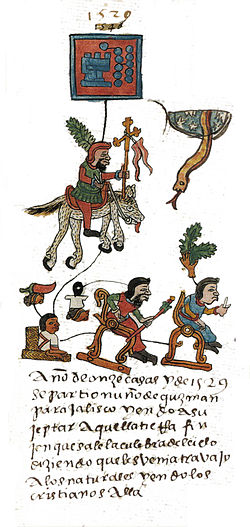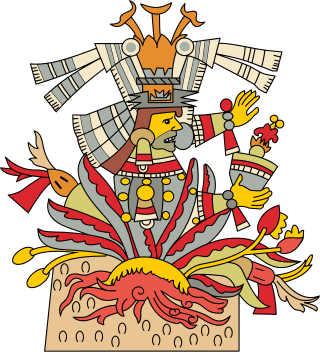
Mayahuel is the female deity associated with the maguey plant among cultures of central Mexico in the Postclassic era of pre-Columbian Mesoamerican chronology, and in particular of the Aztec cultures. As the personification of the maguey plant, Mayahuel is also part of a complex of interrelated maternal and fertility goddesses in Aztec religion and is also connected with notions of fecundity and nourishment.
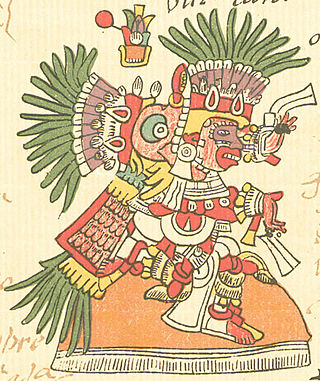
Tlahuizcalpantecuhtli is a principal member of the pantheon of gods within the Aztec religion, representing the Morning Star Venus. The name comes from the Nahuatl words tlāhuizcalpan "dawn" and tēcutli "lord". Tlahuizcalpantecuhtli is one of the thirteen Lords of the Day, representing the 12th day of the Aztec trecena.

Bernardino de Sahagún, OFM was a Franciscan friar, missionary priest and pioneering ethnographer who participated in the Catholic evangelization of colonial New Spain. Born in Sahagún, Spain, in 1499, he journeyed to New Spain in 1529. He learned Nahuatl and spent more than 50 years in the study of Aztec beliefs, culture and history. Though he was primarily devoted to his missionary task, his extraordinary work documenting indigenous worldview and culture has earned him the title as “the first anthropologist." He also contributed to the description of Nahuatl, the imperial language of the Aztec Empire. He translated the Psalms, the Gospels, and a catechism into Nahuatl.
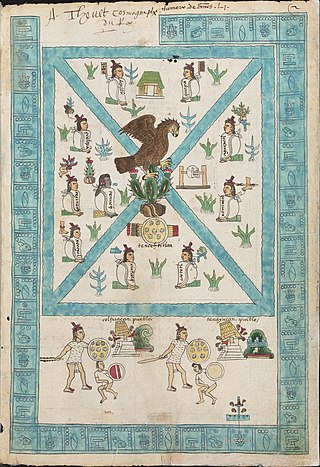
The Codex Mendoza is an Aztec codex, believed to have been created around the year 1541. It contains a history of both the Aztec rulers and their conquests as well as a description of the daily life of pre-conquest Aztec society. The codex is written using traditional Aztec pictograms with a translation and explanation of the text provided in Spanish. It is named after Don Antonio de Mendoza (1495-1552), the viceroy of New Spain, who supervised its creation and who was a leading patron of native artists.

Maya codices are folding books written by the pre-Columbian Maya civilization in Maya hieroglyphic script on Mesoamerican bark paper. The folding books are the products of professional scribes working under the patronage of deities such as the Tonsured Maize God and the Howler Monkey Gods. The codices have been named for the cities where they eventually settled. The Dresden codex is generally considered the most important of the few that survive.

Aztec codices are Mesoamerican manuscripts made by the pre-Columbian Aztec, and their Nahuatl-speaking descendants during the colonial period in Mexico.
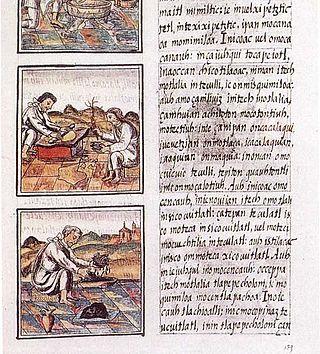
The Florentine Codex is a 16th-century ethnographic research study in Mesoamerica by the Spanish Franciscan friar Bernardino de Sahagún. Sahagún originally titled it: La Historia General de las Cosas de Nueva España. After a translation mistake, it was given the name Historia general de las Cosas de Nueva España. The best-preserved manuscript is commonly referred to as the Florentine Codex, as the codex is held in the Laurentian Library of Florence, Italy.

Codex Ríos is an Italian translation and augmentation of a Spanish colonial-era manuscript, Codex Telleriano-Remensis, that is partially attributed to Pedro de los Ríos, a Dominican friar working in Oaxaca and Puebla between 1547 and 1562. The codex itself was likely written and drawn in Italy after 1566.

The Codex Borbonicus is an Aztec codex written by Aztec priests shortly before or after the Spanish conquest of the Aztec Empire. It is named after the Palais Bourbon in France and kept at the Bibliothèque de l'Assemblée Nationale in Paris. The codex is an outstanding example of how Aztec manuscript painting is crucial for the understanding of Mexica calendric constructions, deities, and ritual actions.

The traditions of indigenous Mesoamerican literature extend back to the oldest-attested forms of early writing in the Mesoamerican region, which date from around the mid-1st millennium BCE. Many of the pre-Columbian cultures of Mesoamerica are known to have been literate societies, who produced a number of Mesoamerican writing systems of varying degrees of complexity and completeness. Mesoamerican writing systems arose independently from other writing systems in the world, and their development represents one of the very few such origins in the history of writing.
The Codex Mexicanus is an early colonial Mexican pictorial manuscript.
Fray Pedro de los Ríos was a Domician missionary in New Spain in the mid-16th century. Little is known about him, but he contributed to the creation of the manuscripts now known as the Codex Telleriano-Remensis and Codex Vaticanus A, which describe Aztec culture and history. The Codex Vaticanus A is also known as the Codex Ríos, after Pedro de los Ríos.
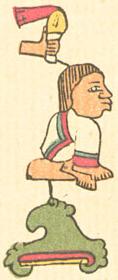
Xilomantzin was the tlatoani ("king") of the pre-Columbian altepetl of Culhuacan in the Valley of Mexico from 1440 to 1473.
Eloise Quiñones Keber was Professor Emeritus of Art History at Baruch College and The Graduate Center, CUNY, where she specialized in Pre-Columbian and early colonial Latin American art. She earned her Ph.D from Columbia University in 1984.
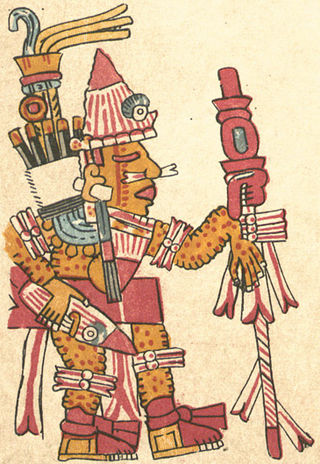
In Aztec religion, Itztapaltotec is an aspect of the fertility god Xipe Totec. In the Aztec calendar, he is one of the patrons of the trecena beginning with the day One Rabbit, alongside Xiuhtecuhtli, the god of fire. Xipe Totec proper is the patron of the trecena beginning with the day One Dog. Itztapaltotec is an obscure figure, known only from tonalamatl (calendars). Brief, confusing information about him is given in two related manuscripts, the Codex Telleriano-Remensis and the Codex Ríos.
Henry Bigger Nicholson who published under the name H.B. Nicholson, was a scholar of the Aztecs. His major scholarly monograph is Topiltzin Quetzalcoatl: The Once and Future Lord of the Toltecs (2001).
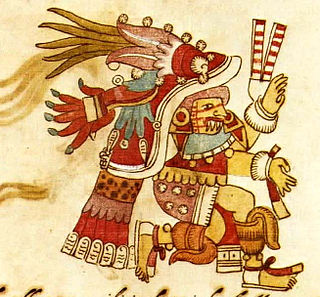
In Aztec religion, Chantico is the deity reigning over the fires in the family hearth. She broke a fast by eating paprika with roasted fish, and was turned into a dog by Tonacatecuhtli as punishment. She was associated with the town of Xochimilco, stonecutters, as well as warriorship. Chantico was described in various Pre-Columbian and colonial codices.
The Ralph Waldo Emerson Award is a non-fiction literary award given by the Phi Beta Kappa society, the oldest academic society of the United States, for books that have made the most significant contributions to the humanities. Albert William Levi won the first of these awards, in 1960.
Karl Anton Nowotny was an Austrian ethnographer, art historian and academic, specialising in the study of Mesoamerican cultures. He is most renowned for his analyses and reproductions of Mesoamerican codices, and his commentaries on their iconography and symbolisms.
